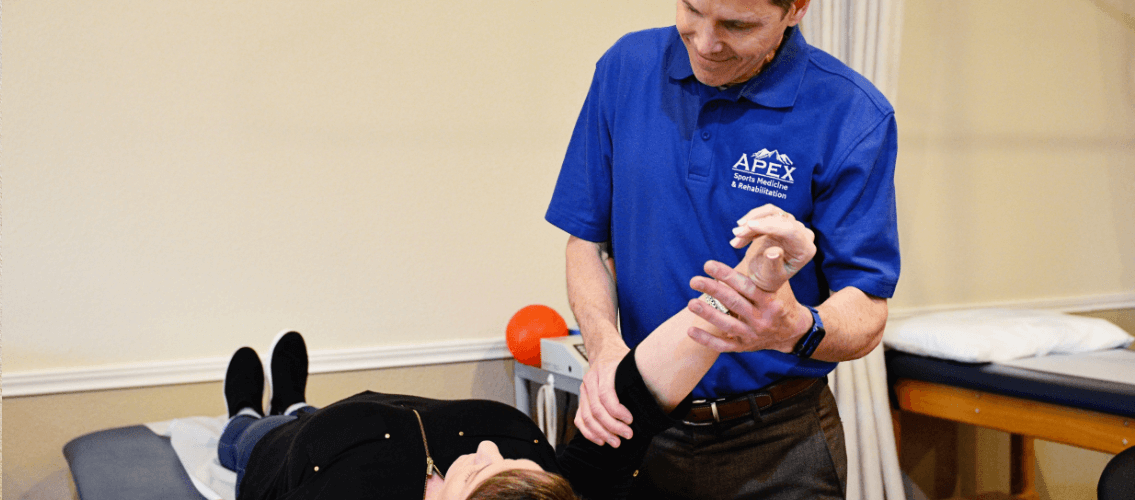Frozen shoulder also known as adhesive capsulitis is a condition identified by stiffness and inflammation in the ligamentous capsule of the shoulder joint. It leads to a limited range of motion in the shoulder joint making it difficult to perform mobility activities.
Frozen shoulder occurs mainly in people recovering from a medical condition such as arm fracture and are advised to not strain their arm. It is also common in women age between 40 to 60 and those who suffer from diabetes.
The symptoms of frozen shoulder occur gradually and worsen over time that limits movements. It may take up to three years for complete recovery. A well-trained physical therapist can treat the frozen shoulder condition.
How Does A Frozen Shoulder Occur?
Even though the exact reason that causes frozen shoulder is unknown, inflammation in the shoulder joint causing adhesions is assumed to be the main reason.
The shoulder is characterized by a ball and socket joint made up of three bones – the long upper arm limb known as the humerus, the shoulder blade called the scapula, and the S-shaped long bone called collarbone or clavicle.
The tissue that surrounds the joint and holds it together is called the capsule. Frozen shoulder mostly occurs when there is an inflammation or pain in the tissue surrounding the joints.
The capsule has folds that can expand and contract when the arms move in different directions. When inflammation occurs in the capsule, it causes scarring which is termed adhesion. As a result, the folds in the capsule are stiffened and the shoulder movements become difficult and painful. This condition is called adhesive capsulitis – adhesive means scarring and capsulitis mean inflammation of the capsule.
Symptoms Of A Frozen Shoulder
The frozen shoulder may develop severe or stabbing pain in the shoulder and outside of the upper arm. The pain affects normal mobility and daily activities. It also leads to an inability to sleep well.
As the symptoms of frozen shoulder gradually develop, it can be divided into three stages.
1) Freezing stage – The patient slowly develops pain that increases day by day and especially the shoulder aches more at night. The pain worsens and leads to a limited range of motion. It can last from six weeks to nine months.
2) Frozen Stage – The range of motion decreases more and more at this stage and stiffness exists. The pain decreases but trying to move the shoulder causes more pain. This stage can last for nine to fourteen months.
3) Thawing Stage – The shoulder movement begins to improve and the patient experiences a decrease in pain especially at night.
Risk Factors
People who had reduced mobility of the shoulder due to fracture or rotator cutoff injury have a high risk of developing frozen shoulder.
Also, people who have diabetes, hypothyroidism, hyperthyroidism, cardiac disease and Parkinson’s disease may develop frozen shoulder.
Physical Therapy Treatment For Frozen Shoulder
Physiotherapy is the most preferred and effective treatment to get rid of frozen shoulder. Physical therapists can guide the patients to improve their range of motion gradually through certain exercises.
1) Acupuncture
A well-trained therapist may carry out this treatment by inserting fine needles into the patient’s skin at specific points. Throughout the treatment that may occur for about 15 to 40 minutes, the needles may be moved or manipulated.
Acupuncture treatment is mostly painless as the needles are thin and flexible. This treatment reduces the pain in the shoulder and upper arms.
2) Postural Realignment
In this treatment, the therapist will examine the stiffened and weak muscles that caused poor posture. After the assessment, the therapist will suggest some exercises to strengthen the weak muscles and loosen the stiff muscles that led to the frozen shoulder.
Doing these exercises regularly will reduce the pain in the shoulder, improves posture and increases the range of motion.
3) Kinesio Taping
As frozen shoulder has reduced normal movements, Kinesio taping method is adopted by the therapists to provide improved stability to the joints, reduce pain and activate the shoulder muscles.
The Kinesio Tape is an elastic therapeutic tape made up of cotton fibre and heat-activated sweat-proof adhesive. The tape when applied to the shoulder acts as a supportive tool to improve movements without causing pain.
4) Transcutaneous Electrical Nerve Stimulation (TENS)
The TENS unit consists of a battery-powered device that sends electrical impulses through the electrodes that are placed on the shoulder area where the pain is experienced. These electrical impulses stimulate the nerve tissues to block the transfer of pain signals in the body.
It also improves the number of endorphins which are the human body’s natural painkillers. TENS can reduce pain in the shoulder and speeds up the recovery process.
5) Exercises
Along with the above-said treatments, the physical therapist will also recommend some exercises to be done at home. It includes strengthening and stretching exercises that target the shoulder area and core muscles.
Final Thoughts
As the main cause of frozen shoulder is unknown and debatable, no preventive measures have been found. Hence it is advisable to watch over the symptoms such as pain or immobility in the shoulder and contact your physical therapist as soon as possible.


